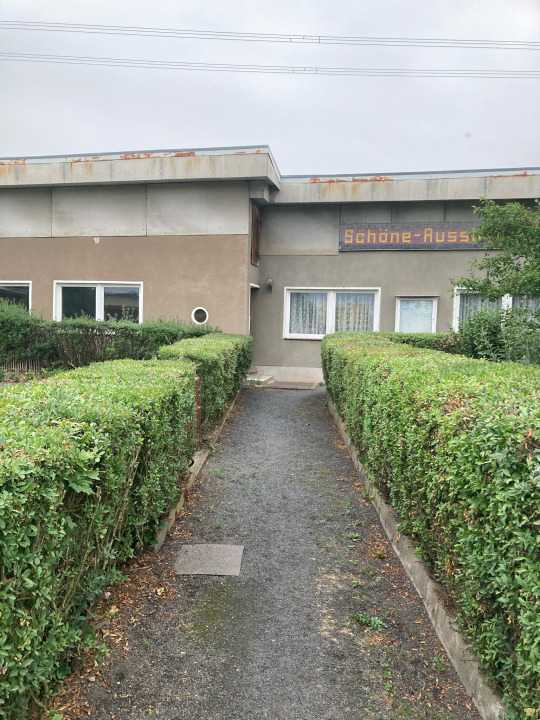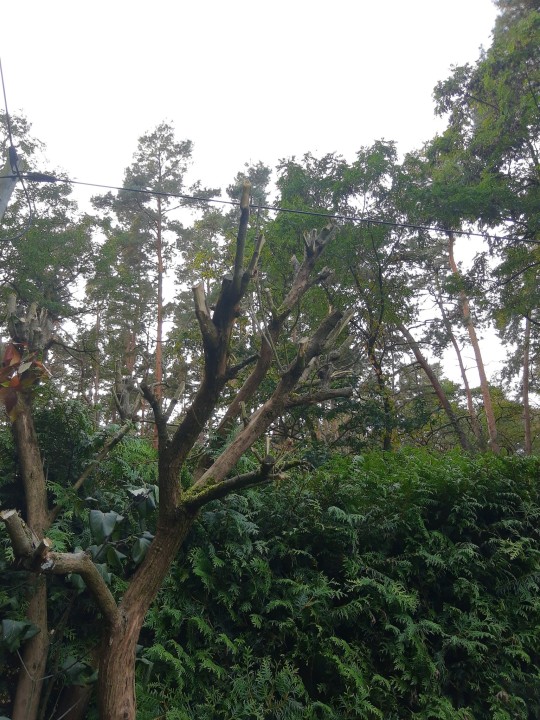#kleingarten
Text

Kleingartenanlage „Schöne Aussicht“, Juni 2022

54 notes
·
View notes
Text
Winter is, apparently, a very bad time to become enthusiastic about gardening, guerilla or otherwise. I found great ressources for native plants for Germany, even if they are a bit pricey for me. I'll list them below. I have at least four or five different plots around my building that have so much potential, not to mention some lawn in the backyard that would improve soooo much with the addition of some wildflowers and herbs.
On some of the sites, there are pretty detailed pictures of transformations, and they have me vibrating with the need to DO SOMETHING NOW!!!
But alas, I cannot. At least not much, anyway. For now, I keep the spaces litter-free, and restore any structural elements like stone framings, etc. I would also weed them, but I don't think it will be all that useful.
There is a piece of grain that just started growing in one of them, and grew big, and the company who came to mow the lawn cut it down and left the pieces lying around. I will try to get some seeds from it and maybe use the pieces as mulch to bolster the patches where I put the bulbs in.
Edit: I just learned that there are still some things I can plant in November, that are also perfect for growing under trees: Christrosen (christmas roses), Blaustern (squill), and Waldmeister (woodruff), to name three. Now I need to find some. I think a trip to our garden market is in order. I'll go to seed swap meetings next year, and maybe source other local stuff, but for now, this is what I can do.
Wildblumen und -kräuter für den Privathaushalt kaufen
Herkunftsgebiete
Was im November im Garten zu tun ist
Was pflanze ich unter Bäume?
Gefährdete Pflanzenarten nach Bundesland (Conservation Gardening App)
2 notes
·
View notes
Text




So endet das Bungalow-Jahr 2022.
Der Rotahorn, der noch alle Blätter trägt, wurde zu groß und ausladend (die oberen Bilder). Das Zurückschneiden ist eine Wissenschaft für sich. Egal, es mußte sein. Die unteren Bilder zeigen das Ergebnis. Wir werden nächstes Jahr sehen, ob der Busch gelitten hat.
2 notes
·
View notes
Photo

#muralasguesture #windows #middlefinger #fuckoff #stopnuclearpower #haraldjuch #stinkefinger #ftp #atommeiler #kleinkind #manduca #mgs #magics #kleingarten #schöneberg #hausbesetzung #spurloser https://www.instagram.com/p/CfxEy3rIeQU/?igshid=NGJjMDIxMWI=
#muralasguesture#windows#middlefinger#fuckoff#stopnuclearpower#haraldjuch#stinkefinger#ftp#atommeiler#kleinkind#manduca#mgs#magics#kleingarten#schöneberg#hausbesetzung#spurloser
4 notes
·
View notes
Photo

🚩 HEUREKA! TOLLES GRUNDSTÜCK, WELCHES ZUR SOMMERNUTZUNG EINLÄDT!
Dieses, mit einen herrlichen Fernblick ins Grüne, im Kleingartengebiet gelegene Grundstück, sucht neue Besitzer. Interessiert? Dann rufen Sie uns an: +43 699 15152424
Objekt-Nr.: 1381 (Details: https://bit.ly/3NjAmp4)
#meinbezirk#meinmakler#kleinpartner#wien#hietzing#makler#experte#kleingarten#grundstueck#kaufen#realestate#forsale#immobilien
0 notes
Text
Unter Kleingärtnern in Travemünde
Das "Betreten der Anlage" geschehe nur auf "eigene Gefahr" und parken wird höchstens auf entsprechend gekennzeichneten Flächen erlaubt und, natürlich, nur mit einem sichtbaren sowie gültigen Parkausweis.
Unter Kleingärtnern
in Travemünde
Das “Betreten der Anlage” geschehe nur auf “eigene Gefahr” und parken wird höchstens auf entsprechend gekennzeichneten Flächen erlaubt und, natürlich, nur mit einem sichtbaren sowie gültigen Parkausweis. Und Hunde sind selbstverständlich anzuleinen sowie das Rad- und Moped fahren verboten. Denn: “Wir sind für Ruhe!”.Besucher, die sich von den trotz dieser…

View On WordPress
#Garten#Kleingarten#Neibausiedlung#Pacht#Parallelwelt#Parazellen#Politiker#Ruhe#Spießer#Travemünde#Travemünder Kleingartenverein#Weltkrieg
0 notes
Photo

So, die Johannesbeeren sind verarbeitet. Die Stiele entfernt und gut gewaschen. Ich habe sie pürriert im Standmixer (selbst gekauft) und dann Gelierzucker hinzugegeben. In diesem Falle waren es 2:1 Gelierzucker, 3 Packungen. Ich probiere es immer aus ob die Marmelade auf einem kleinen Teller gut fest wird, dann habe ich die richtige Menge, steht aber auch auf der Packung. Hinzugegeben habe ich noch 2 Päckchen Vanillezucker, 1 Prise Salz, abgeriebene BIO-Zitronenschale und etwas Zimt, 1 Stengel Lavendelblüte. So schmeckt die Marmelade doch noch etwas ungewöhnlicher... aber lecker... geht aber auch ohne. Wer mag kann auch einen leichten Hauch Pfeffer hinzugeben... habe ich aber vergessen, egal, ist auch so superlecker. Wer die Kerne nicht mag sollt vorher entsaften. #OliviasDelights #marmelade #marmeladekochen #sweetandsour #lecker #bio #hausgemacht #selbstgemacht #yummy #schräbergarten #rezepte #kleingarten #selbstversorger (hier: Ilsenburg) https://www.instagram.com/p/CgNFqFhsV1z/?igshid=NGJjMDIxMWI=
#oliviasdelights#marmelade#marmeladekochen#sweetandsour#lecker#bio#hausgemacht#selbstgemacht#yummy#schräbergarten#rezepte#kleingarten#selbstversorger
0 notes
Photo

Ihanaa perjantaita! 🌸 Olen ostanut kolme tällaista tuikkukuppia aikoinaan Japanista. Ne ovat olleet aarteeni, sitten niistä kaksi hajosi. Tämän viimeisen toin sisälle turvaan. Siitä tulikin ihana pikkumaljakko! ps. bongaa Miso 🐈⬛ peilistä! ♥️ @oravankesapesa #oravankesäpesä #siirtolapuutarha #allotmentgarden #koloni #koloniträdgård #kolonihave #schrebergarten #kleingarten #bauerngarten #siirtolapuutarhamökki #allotmentcottage #kolonistuga #allotmentlife #kolonihaveliv #siirtolapuutarhaelämää #visualoflife #softminimalism #itsallaboutthedetails #awakethelight #forprettysake #poetryofsimplethings #amomentofwonder #myfairytale #cozymoments #make_more_magic #beautyundermynose #slowandglow #inspiredliving #misotheexotic https://www.instagram.com/p/CfvigqMNaeQ/?igshid=NGJjMDIxMWI=
#oravankesäpesä#siirtolapuutarha#allotmentgarden#koloni#koloniträdgård#kolonihave#schrebergarten#kleingarten#bauerngarten#siirtolapuutarhamökki#allotmentcottage#kolonistuga#allotmentlife#kolonihaveliv#siirtolapuutarhaelämää#visualoflife#softminimalism#itsallaboutthedetails#awakethelight#forprettysake#poetryofsimplethings#amomentofwonder#myfairytale#cozymoments#make_more_magic#beautyundermynose#slowandglow#inspiredliving#misotheexotic
0 notes
Photo

Einfach nur schön. #kleingarten #natur #sattefarben https://www.instagram.com/p/CfGxXPAIq6q/?igshid=NGJjMDIxMWI=
0 notes
Text


#press archive#bild#leipzig#07182016#gift-alarm im kleingarten#paunsdorf#kaolin#missale#henry duldhardt#wu denim
0 notes
Text
In my ‘I just want a fenced in garden to grow shit and hang out with my dog’ era
#zombie thoughts#seriously#i can't think of a single job i could do because human interaction is SO DRAINING for me#half an hour with even just one person makes me want to curl up under a blanket for the rest of the day#even if it's people i like! i like K! geddy likes K! and i like Mrs Upstairs! she's a very sweet lady! but human interaction is too much!!!#i thought bookbinding would be good but like... i'd have to complete an ausbildung and i'd probably end up in a factory#0/10 i do not want that#factories are too loud#why are there no autism friendly jobs#i want a kleingarten.#i will grow fruits and veggies and flowers for bees and hang out with my dog
0 notes
Text


Es ist tatsächlich 6 Jahre her, dass ich den Flieder so zurückgeschnitten habe.
Läßt sich in diesem Blog sehr gut nachvollziehen.
Nun also erneuter Schnitt. Die Äste und Zweige waren der Telefonleitung oberhalb sehr nahe.
#bungalow#garten#allotment#schrebergarten#kleingarten#brandenburg#laube#land brandenburg#autumn#oktober 2023
1 note
·
View note
Text
Scattered throughout Germany are collections of what look like tiny houses surrounded by well-kept gardens. But people don't live in these small structures with flourishing yards. These are allotment gardens — a take on community gardens also known as Kleingarten or Schrebergarten. Originally developed to facilitate health and wellness, these gardens are described by The Local as a "a concept, a goal, a way of life."
In the early 1800s during a strong period of urbanization when many people had moved to the cities for work, impoverished families often had difficulty finding enough to eat. Some churches, city administrators and factory owners offered to lease them community land for a small fee so that they could grow their own food. These became known as Armengarten, or gardens for the poor, according to DW.com.
As urbanization continued, Dr. Moritz Schreber, a doctor and teacher from Leibzig, was concerned that children raised in the city would suffer both physically and emotionally if they didn't have more outdoor experiences. He proposed the concept of playgrounds where everyone could get physical exercise and enjoy the outdoors. Just a few years after he died, the idea gained traction and the concept of Schrebergarten was named for him, reports the Local.
The early spaces were mostly play areas on the outskirts of town. But families quickly realized there was value in the land and also began planting gardens in their outdoor plots.
While the kids ran around and soaked in all that fresh air, the adults grew vegetables for the family. But there was downtime for them, too. They pulled up their chairs and talked or played cards. The gardens evolved into a hub for relaxation and social life for everyone in the family. The gardens also became known as Kleingarten ("small garden") or Familiengarten ("family garden").
Most of the plots were converted completely to family gardens by World War I, and those plots helped a hungry populace survive both world wars, reports German Girl in America.
As the popularity of the gardens grew, laws were passed to keep leasing fees reasonable. The plots of land were kept in the family, passed down from generation to generation as long as the fees were paid.
Many of the gardens were located in relatively undesirable areas where most people didn't want to live, like along railroad tracks, airports and even on both sides of the Berlin Wall. They were usually grouped together in colonies, forming communities.
A way of life
Though they are no longer a necessity, Kleingarten are now considered a luxury or, some say, a key pillar to a recreational way of life.
These days, there are about 1 million allotment gardens in Germany and 95% of them are occupied, according to a study by the German Institute for Construction, City and Space Research.
The average age of a garden association member is 56, a drop in about five years since 2011.
"The allotment garden system continues to have a permanent place in the green and open space system of cities and fulfills important social, ecological and urban planning functions," the study authors write. "The allotment garden is rejuvenating: the generation change is becoming more noticeable ... The main reason for this is the increased demand from young households, mostly families with children, who are also becoming more international. In the big cities, club members are more often younger than in the smaller cities."
And these younger people appreciate the opportunity to be outdoors.
"Overall, this also reflects an increasing need to become more involved in nature and environmental protection and to use, secure and make green and open spaces, especially in the metropolitan areas, as places of rest and relaxation," the researchers write.
Garden laws and waiting lists
Gardens now are often so much more than just a few veggie plants. They can be elaborate spaces with loads of flowers, water features, barbecue grills and even the occasional garden gnome. They are spots for people to relax and socialize and enjoy the outdoors.
But it's not easy to just grab a plot and start growing. There's often a waiting list. According to the BBC, Berlin's gardens have a waiting list of 12,000 people, and it typically takes at least three years to get a plot.
And as attractive as the gardens might be now, with their colorful flowers and home-like accouterments, there are national laws to control what goes on in the plots. The garden huts can't be too big or used as residences, according to DW.com, and at least one-third of the garden must be used to grow fruits and vegetables.
But for many, the balance of rules versus relaxation is worth it, as generations mingle in the gardens.
"The amount of work that goes into taking care of the garden also makes you appreciate what you're eating — and makes you realize what's in season," Paul Muscat, 32, of Wedding, Germany, tells the BBC. "Except for the parks, there’s no immediate escape from the urban environment. This offers a reprieve from that."
Updated February 22, 2020
2 notes
·
View notes